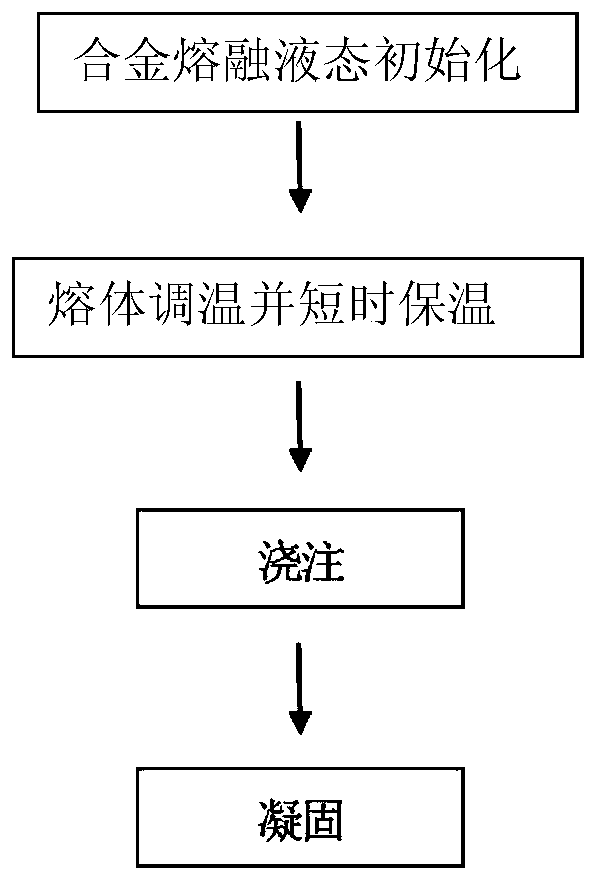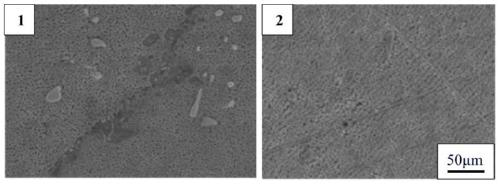Method for improving intermetallic compounds in casting alloys
A technology of intermetallic compounds and casting alloys, which is applied in the field of improving intermetallic compounds in casting alloys, can solve problems such as material brittle fracture, achieve the effects of reducing the number, improving comprehensive mechanical properties, refining and uniform distribution
- Summary
- Abstract
- Description
- Claims
- Application Information
AI Technical Summary
Problems solved by technology
Method used
Image
Examples
Embodiment 1
[0069] The GH4169 alloy has a large tolerance of material expansion and contraction recovery run-out, so that the material is used under high temperature and harsh conditions. Before the fatigue life of the material expires, the tolerance of the material cycle deformation recovery fluctuation becomes larger and larger until it exceeds the limit value and is scrapped. It has become a hot spot in the industry to solve the microstructure stability of the intermediate metal compound of the material and then reduce the expansion and contraction rebound value during the use of the material. Under this process, the expansion and contraction recovery run-out tolerance of the material has been significantly changed.
[0070] Table 1 Main chemical composition of GH4169 alloy
[0071] C Cr Ni co Mo ≤0.08 17.0-21.0 50-55.0 0.02-1.0 2.80-3.30 Al Ti Nb Si Fe 0.30-0.70 0.75-1.15 4.85-5.40 ≤0.2 Remain
[0072] The main intermetallic compounds ...
Embodiment 2
[0119] The yield of iron-based alloy M42 is only 45% due to material brittleness in the process of rolling thin plates (thickness below 1.5mm), and the service life of thin plate materials is not optimistic. Through the process of the invention, the finished product rate of the alloy M42 thin plate is increased to 80%, and the service life is increased to 3 times of the original one. This is because the present invention changes the material macro effect brought about by the microstructure of the alloy intermetallic compound.
[0120] Table 4 Main chemical composition of iron-based alloy M42
[0121]
[0122]
[0123] The main intermetallic compounds in the iron-based alloy M42 are shown in Table 5.
[0124] Table 5 Melting points of compounds in M42 alloy (°C)
[0125] Simple substance melting point compound melting point compound melting point V 1919 VC 2830 TiC 3160 Mo 2617 Mo 2 C
2690 W 2 C
2730 C 3727 MoC ...
Embodiment 3
[0170] The high-end copper-based alloy ZrCrCu needs to meet both mechanical properties and electrical conductivity, but the mechanical properties and electrical conductivity are contradictory, and improving one of them will weaken the other. The material of the invention is simultaneously improved in terms of mechanical properties and electrical conductivity.
[0171] Table 7 Main chemical composition of copper-based alloy ZrCrCu
[0172] C Cr Zr Fe max0.05 0.8-1.1 0.13-0.2 max0.03 Cu Mg Si mn margin 0.0005-0.008 max0.01 max0.01
[0173] The specific smelting method is as follows:
[0174] Step 1. Copper-based alloy ZrCrCu alloy liquid initialization
[0175] (1) First put the cast alloy raw materials copper, copper chromium and copper zirconium into a quartz crucible, and put the quartz crucible into a vacuum induction melting furnace with magnetic stirring function, then vacuumize, and when the vacuum degree reaches below 9Pa ...
PUM
 Login to View More
Login to View More Abstract
Description
Claims
Application Information
 Login to View More
Login to View More - R&D
- Intellectual Property
- Life Sciences
- Materials
- Tech Scout
- Unparalleled Data Quality
- Higher Quality Content
- 60% Fewer Hallucinations
Browse by: Latest US Patents, China's latest patents, Technical Efficacy Thesaurus, Application Domain, Technology Topic, Popular Technical Reports.
© 2025 PatSnap. All rights reserved.Legal|Privacy policy|Modern Slavery Act Transparency Statement|Sitemap|About US| Contact US: help@patsnap.com



